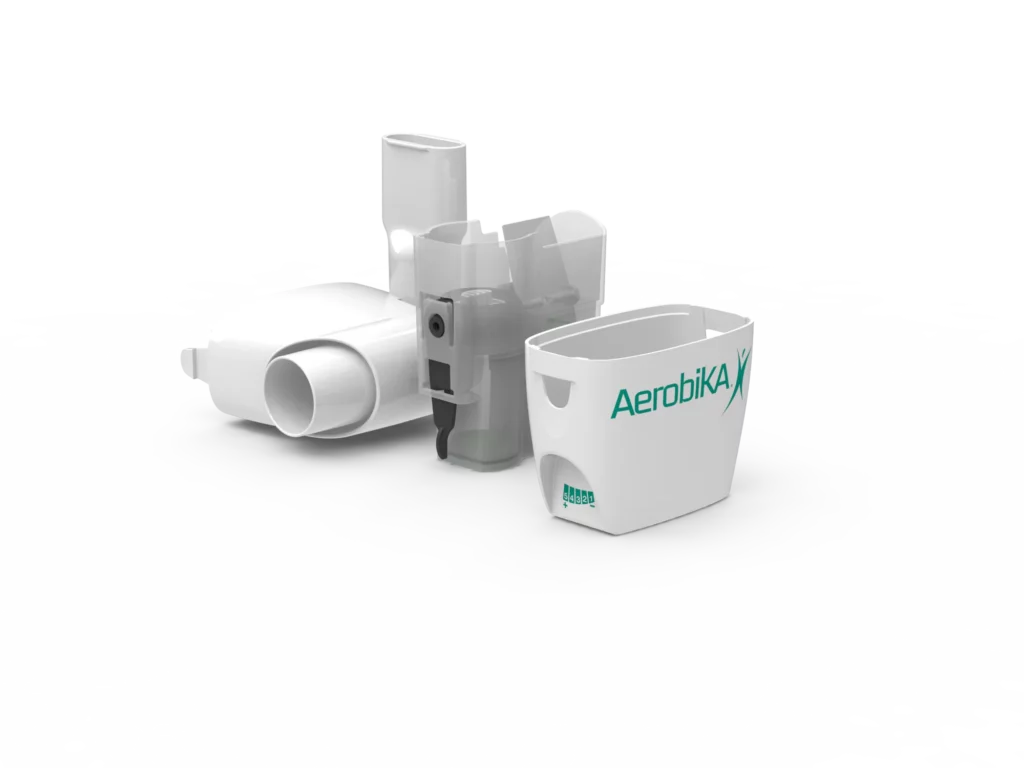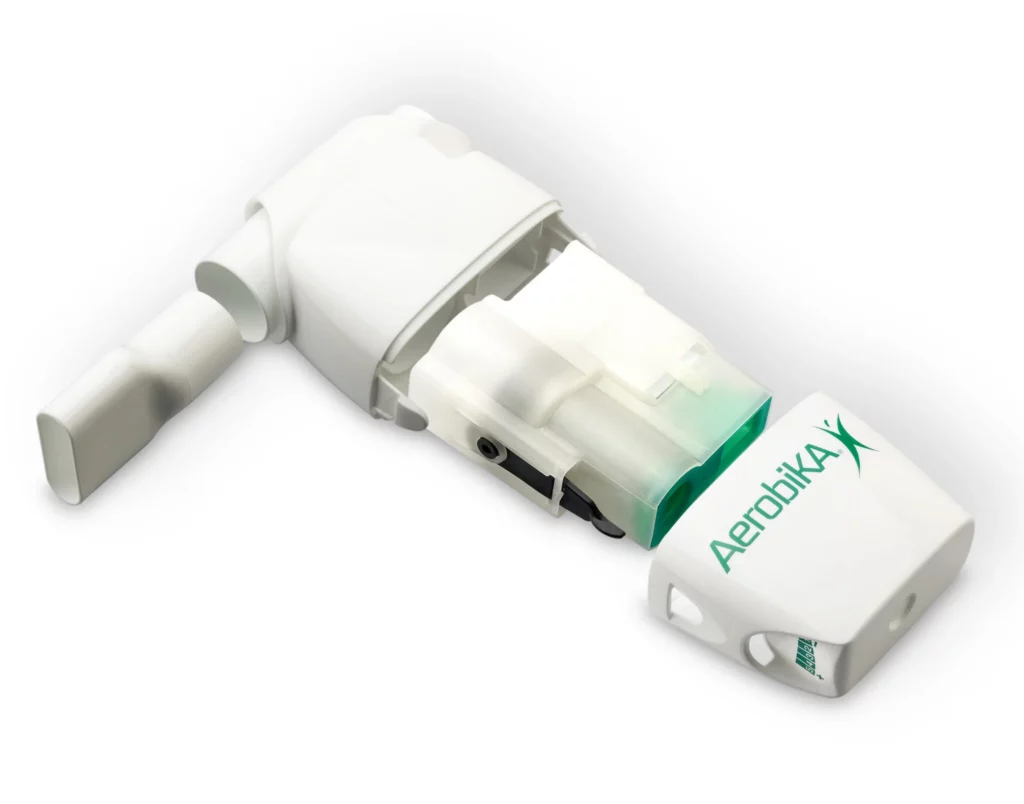The Aerobika device is an important therapeutic tool in respiratory care, designed to help patients with chronic lung conditions manage their respiratory health effectively. This oscillating positive expiratory pressure (OPEP) device plays a critical role in airway clearance for individuals living with conditions such as cystic fibrosis, bronchiectasis, and chronic obstructive pulmonary disease (COPD).
Key Benefits of the Aerobika Device:
- Assists in mucus clearance from airways
- Helps reduce the frequency of respiratory infections
- Improves breathing efficiency
- Supports daily respiratory hygiene routines
The effectiveness of the aerobika device depends on proper maintenance and cleaning protocols. Each use brings the device into contact with respiratory secretions, making thorough cleaning essential for patient safety and optimal therapeutic outcomes. Research shows that consistent device cleaning significantly reduces the risk of respiratory infections and ensures the delivery of intended therapeutic benefits.
A clean Aerobika device means safer, more effective respiratory therapy – a crucial part of successfully managing chronic lung conditions.
Understanding the Aerobika Device and Its Functionality
The Aerobika device operates through a sophisticated oscillating positive expiratory pressure (OPEP) mechanism. When patients exhale through the device, it creates controlled resistance and vibration, generating pressure waves that travel through the airways. These pressure waves help:
- Break up thick mucus deposits
- Move secretions from small airways to larger ones
- Enhance airway clearance efficiency
- Improve lung ventilation

Target Patient Groups:
- Individuals with Cystic Fibrosis
- Bronchiectasis patients
- COPD sufferers
- Those with chronic bronchitis
- Patients recovering from respiratory infections
The device’s effectiveness stems from its ability to create optimal pressure-flow relationships during exhalation. A resistance dial allows personalisation of therapy settings based on individual patient needs and respiratory capabilities.
Daily Usage Protocol:
- 10-20 breaths per session
- 2-4 sessions per day
- Each session lasting approximately 10-15 minutes
- Breathing pattern: slow, deep inhalation followed by active exhalation
The Aerobika device’s consistent use forms a critical component of respiratory health management. Proper technique involves sitting upright, maintaining a good seal around the mouthpiece, and following prescribed breathing patterns. This systematic approach helps mobilise secretions effectively while strengthening respiratory muscles through regular therapeutic exercise.
Read about oxygen concentror at: Oxygen Concentrator Philips EverFlo Review
The Importance of Cleaning Your Aerobika Device
Regular cleaning of the Aerobika device is crucial for patient safety and effective treatment. Since the device comes into direct contact with mucous membranes and respiratory secretions, it can become a breeding ground for bacteria and other microorganisms if not cleaned properly.
Understanding Bacterial Contamination in Airway Clearance Devices
Research studies have found significant rates of bacterial contamination in airway clearance devices:
- Up to 65% of uncleaned devices show presence of potentially harmful bacteria
- Common contaminants include Staphylococcus aureus and Pseudomonas aeruginosa
- Bacterial colonies can double every 4-6 hours in warm, moist conditions Learn more about bacteria on https://micro.magnet.fsu.edu/cells/bacteriacell.html
The Consequences of Improper Cleaning Practices
Improper cleaning practices can lead to serious health complications:
- Respiratory tract infections
- Cross-contamination between different areas of the airways
- Reduced device effectiveness due to blockage from dried secretions
- Biofilm formation – resistant bacterial communities that are difficult to eliminate
A study published in the Journal of Cystic Fibrosis demonstrated that contaminated airway clearance devices can introduce pathogens directly into the lower respiratory tract, potentially causing severe infections in vulnerable patients.
Factors That Increase the Risk of Device Contamination
The risk of device contamination increases with:
- Extended periods between cleaning
- Incomplete drying after cleaning
- Storage in humid environments
- Sharing devices between patients
- Using tap water for cleaning instead of sterile solutions
Recommended Cleaning Frequency for the Aerobika Device
The Aerobika device requires consistent cleaning after each therapy session to maintain optimal performance and hygiene standards. Daily users must clean their device following every use to prevent mucus accumulation and bacterial growth.
Manufacturer guidelines specify:
- After Each Use:
- Disassemble and clean all components
- Remove visible debris and secretions
- Air dry completely before next use
- Weekly Deep Clean:
- Complete disinfection of all components
- Thorough inspection of device parts
- Replacement of damaged components
Research demonstrates that adhering to these cleaning frequencies reduces bacterial colonisation by up to 99% when compared to devices cleaned irregularly. A study published in the Journal of Cystic Fibrosis found that daily cleaning protocols significantly decreased the presence of harmful pathogens such as Pseudomonas aeruginosa and Staphylococcus aureus.
For patients using the device multiple times per day, additional cleaning sessions between uses might be necessary, particularly in cases of heavy secretions or during respiratory infections.
Step-by-Step Guide to Cleaning Your Aerobika Device
Proper cleaning of the Aerobika device requires attention to detail and a systematic approach. Following these precise steps ensures optimal device maintenance and hygiene: To read more about hygiene click here.
1. Device Disassembly
- Remove the mouthpiece from the main body
- Separate the two halves of the device body
- Extract the internal resistance dial
- Place all components on a clean surface
2. Cleaning Solution Preparation
- Fill a clean container with warm water (40-50°C)
- Add mild, unscented dish soap
- Avoid harsh detergents or antibacterial soaps
3. Soaking Process
- Submerge all components in the soapy solution
- Allow parts to soak for 10-15 minutes
- Ensure complete coverage of all surfaces
4. Thorough Cleaning
- Use a soft-bristled brush for gentle scrubbing
- Pay special attention to crevices and joints
- Remove visible mucus and debris
- Handle the resistance dial with extra care
5. Rinsing Protocol
- Use filtered or sterile water at room temperature
- Rinse each component thoroughly
- Continue rinsing until water runs clear
- Remove all soap residue
6. Drying and Reassembly
- Place parts on a clean, lint-free cloth
- Position components to allow proper air circulation
- Leave to air dry completely (4-6 hours)
- Check parts are fully dry before reassembly
- Reconnect components in reverse order of disassembly
Note: Avoid using paper towels or tissues for drying as they may leave particles behind. Direct sunlight exposure during drying is not recommended as it may damage the device components.
If you’re using an oxygen machine alongside your Aerobika device, like the Philips Everflo™ Oxygen Concentrator, ensure that you follow the manufacturer’s instructions for cleaning and maintenance specific to those devices as well.
Disinfection Methods for Your Aerobika Device: What You Need to Know
Proper disinfection of the Aerobika device requires specific methods to ensure both effectiveness and device longevity. The following approved disinfection options provide optimal results when implemented correctly:
Boiling Method
- Place disassembled parts in boiling water (100°C)
- Maintain gentle boil for 5 minutes maximum
- Remove parts using sterile tongs
- Allow to cool naturally on clean paper towels
Cold Disinfection Options
- 70% isopropyl alcohol solution: Soak parts for 5 minutes
- 3% hydrogen peroxide: Immerse components for 30 minutes
- Commercial cold sterilising solutions: Follow product-specific timing
Critical Safety Note: Never exceed recommended soaking times as this may compromise device materials
Manufacturer Guidelines
- Disinfect device weekly when used daily
- Avoid harsh chemicals including bleach
- Prevent exposure to extreme temperatures
- Check for material degradation after each disinfection
Component Protection
- Handle resistance dial with extra care during disinfection
- Protect rubber seals from prolonged chemical exposure
- Inspect all parts for damage before reassembly
- Replace components showing signs of wear
The effectiveness of these disinfection methods depends on proper pre-cleaning. Each component must be thoroughly cleaned before implementing any disinfection protocol to ensure optimal results.
Common Misconceptions About Device Sterility and Cleaning Practices Debunked
Several misconceptions exist regarding the cleaning and sterility of respiratory devices like the Aerobika. Understanding these myths helps patients maintain realistic expectations while following proper hygiene protocols.
Myth #1: Regular Cleaning Achieves Complete Sterility
Thorough cleaning significantly reduces bacterial presence but does not guarantee complete sterility. Research indicates that even meticulous cleaning protocols achieve a reduction rather than elimination of microorganisms. This reduction remains sufficient for safe device use when proper cleaning protocols are followed.
Myth #2: All Cleaning Methods Are Equally Effective
Different cleaning approaches yield varying levels of microbial load reduction:
- Simple rinsing – removes visible debris but leaves significant bacterial contamination
- Soap and water – reduces microbial load by 90-99%
- Disinfection methods – can achieve up to 99.9% reduction
Myth #3: Nebulizer Guidelines Apply Universally
While nebulizer cleaning guidelines provide a useful framework, airway clearance devices like the Aerobika face unique challenges. The device’s specific design features require tailored cleaning approaches. Current infection control guidelines lack consensus on protocols exclusive to oscillating positive expiratory pressure devices.
Myth #4: Visual Cleanliness Equals Bacterial Safety
A visually clean device may still harbour microscopic contaminants. Regular disinfection remains essential even when no visible soiling appears. Bacterial growth can occur within 24-48 hours on improperly cleaned surfaces, highlighting the importance of consistent cleaning routines.
Long-Term Maintenance Tips for Your Aerobika Device: Ensuring Effective Therapy Over Time
Proper maintenance of the Aerobika device extends beyond routine cleaning to include regular inspections and careful handling. Users should examine their device before each use, paying attention to:
- Cracks or damage in the plastic components
- Loose or missing parts
- Resistance indicator functioning correctly
- Valve movement and positioning
- Mouthpiece integrity
The device requires gentle handling during cleaning and reassembly. Harsh scrubbing or aggressive cleaning methods can damage the delicate components, particularly:
- The resistance indicator dial
- Internal valve mechanism
- Mouthpiece seal
- Connection points between components
A systematic approach to device inspection helps identify potential issues early:
- Check all seals and connections
- Test the resistance settings
- Verify smooth valve operation
- Examine for discolouration or material changes
- Confirm proper reassembly after cleaning
Patients should maintain a record of when parts need replacement based on manufacturer guidelines. Most components require replacement after 6-12 months of regular use, depending on usage patterns and cleaning frequency.
The Role of Air Liquide Healthcare in Supporting Respiratory Care Patients With Their Devices Like The Aerobika Device
Air Liquide Healthcare is Australia’s leading provider of respiratory care services, supporting tens of thousands of patients across 152 diagnostic and therapy service locations. Founded in 1995, the organisation has expertise in homecare respiratory equipment, including the Aerobika device.
The company’s dedicated healthcare professionals offer:
- Personalised Device Education: One-on-one training sessions ensuring proper device usage
- 24/7 Technical Support: Round-the-clock assistance for device-related queries
- Regular Equipment Checks: Scheduled maintenance services to verify device functionality
- Comprehensive Care Plans: Tailored support strategies for individual patient needs
Air Liquide Healthcare’s extensive network spans major cities and regional areas, providing accessible support services to patients nationwide. The organisation’s commitment to excellence extends beyond equipment supply, encompassing ongoing patient education and support to optimise therapeutic outcomes.
Through partnerships with healthcare providers and continuous investment in staff training, Air Liquide Healthcare maintains high standards in respiratory device support services, benefiting patients requiring airway clearance therapy. This includes providing essential devices such as CPAP machines and CPAP masks, as well as portable oxygen concentrators for those in need.
Conclusion
Proper cleaning and maintenance of the Aerobika device is essential for effective respiratory therapy. The link between device hygiene and patient health outcomes is clear – regular cleaning reduces infection risks and keeps the device working properly.
Key practices for Aerobika device care:
- Clean after each use
- Follow manufacturer-specified disinfection protocols
- Inspect components regularly
- Allow complete air drying
- Store in a clean environment
Patients who make these cleaning practices a part of their daily routine get the most out of their Aerobika device. Taking care of the device leads to better respiratory health and an improved quality of life for people with chronic lung conditions.
To achieve optimal respiratory health, start with a clean and well-maintained Aerobika device – a simple yet powerful tool for managing chronic lung conditions.

